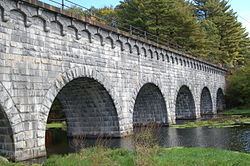Official name Wachusett Aqueduct Maintained by MWRA Conduit height 11 ft (3.4 m) Conduit width 12 ft (3.7 m) Construction began 1897 | Length 9 mi (14.5 km) Opened 1896 Added to NRHP 18 January 1990 Architect Frederick P. Stearns | |
 | ||
Similar Weston Aqueduct, Wachusett Reservoir, Sudbury Aqueduct, Quabbin Aqueduct, Wachusett Dam | ||
The Wachusett Aqueduct is a secondary aqueduct that carries water from the Wachusett Reservoir to the John J. Carroll Water Treatment Plant at Walnut Hill in Marlborough, Massachusetts. It is part of the public water supply system for the communities of Greater Boston that are served by the Massachusetts Water Resources Authority (MWRA), which manages the aqueduct. The aqueduct serves as a standby backup to the Cosgrove Tunnel.
Contents
Physical characteristics
The Wachusett Aqueduct extends from the Wachusett Reservoir in Clinton, through Berlin and Northborough, to the John J. Carroll Water Treatment Plant at Walnut Hill in Marlborough, Massachusetts. This 9-mile (14 km) long water system consists of 2 miles (3 km) of hard rock tunnel and 7 miles (11 km) of 11-foot (3.4 m) high horseshoe-shaped underground aqueduct constructed of non-reinforced concrete with a brick-lined invert. It is not constructed entirely underground and there are several elevated sections. The final portion of the aqueduct, taken out of service in 2005 with the opening of the treatment plant, is an open channel running from near the treatment facility to Sudbury Reservoir.
Modern use
Until the 1960s, the Wachusett Aqueduct was the main conduit used to deliver water from the Wachusett Reservoir. At that time, it carried 300 million US gallons (1,100,000 m3) of water each day (13 m3/s). The Cosgrove Tunnel replaced it in 1965 as the primary water transmission aqueduct. Because of the construction of the Walnut Hill Water Treatment Plant in Marlborough, the Cosgrove Tunnel was shut down in 2003 in order to make the large piping connection between the new treatment plant and the MWRA's new MetroWest Water Supply Tunnel. The MetroWest Tunnel extends east 18.6 miles (29.9 km) from Walnut Hill to Weston. During that shutdown, the Wachusett Aqueduct was the primary method of transmission of about 240 million US gallons (910,000 m3) of water per day. The section of the Wachusett Aqueduct between the Wachusett Reservoir and the treatment plant remains a standby backup transmission path in the event the Cosgrove Tunnel is unavailable, while the open channel between the treatment plant and the Sudbury Reservoir remains an emergency backup transmission path in the event of a major problem with the treatment plant or the primary transmission pathways between the treatment plant and the water system.
The aqueduct's route and supporting structures were added to the National Register of Historic Places in 1990.
It is a Pokémon gym in the mobile game, Pokémon Go.
